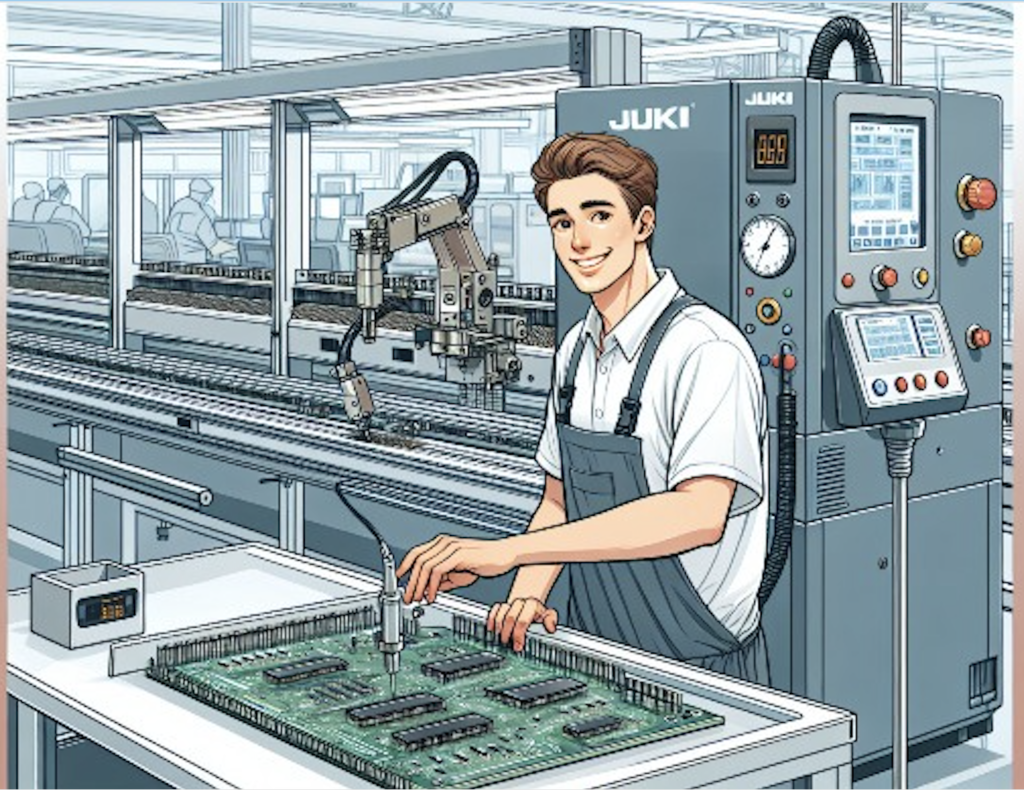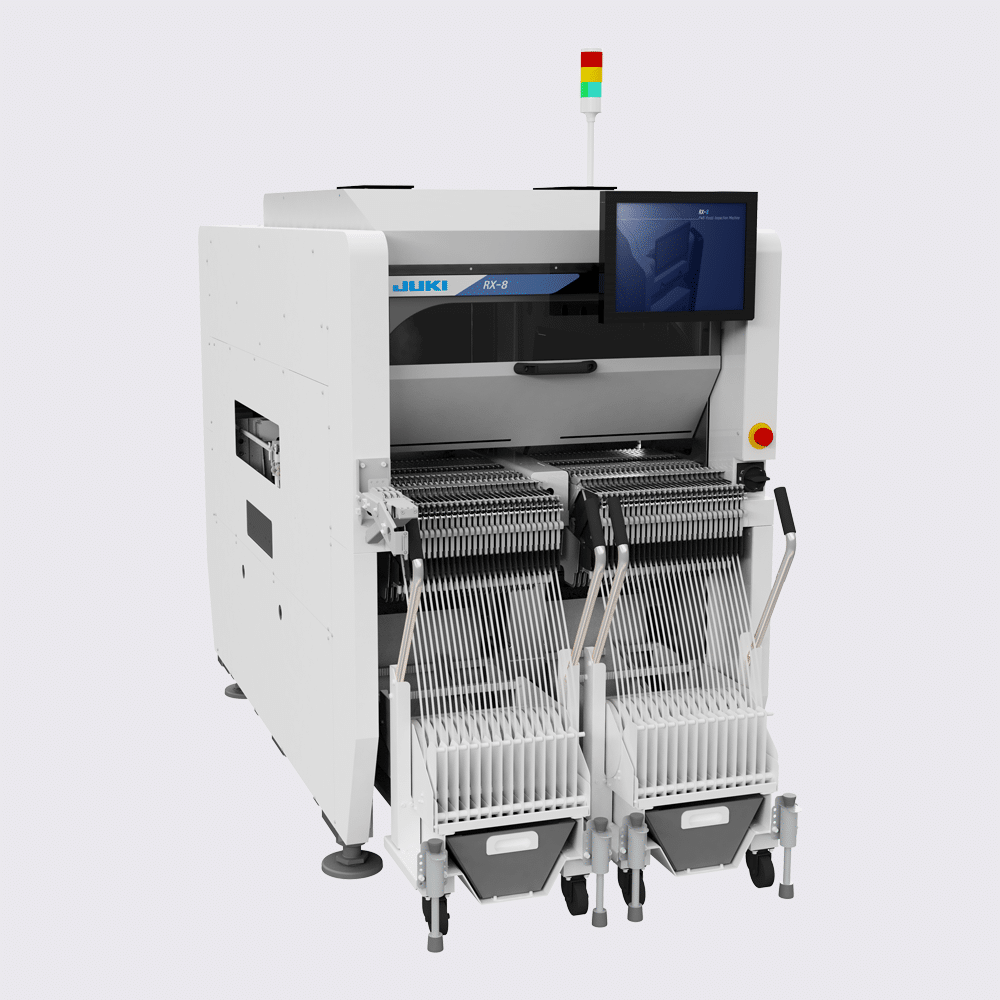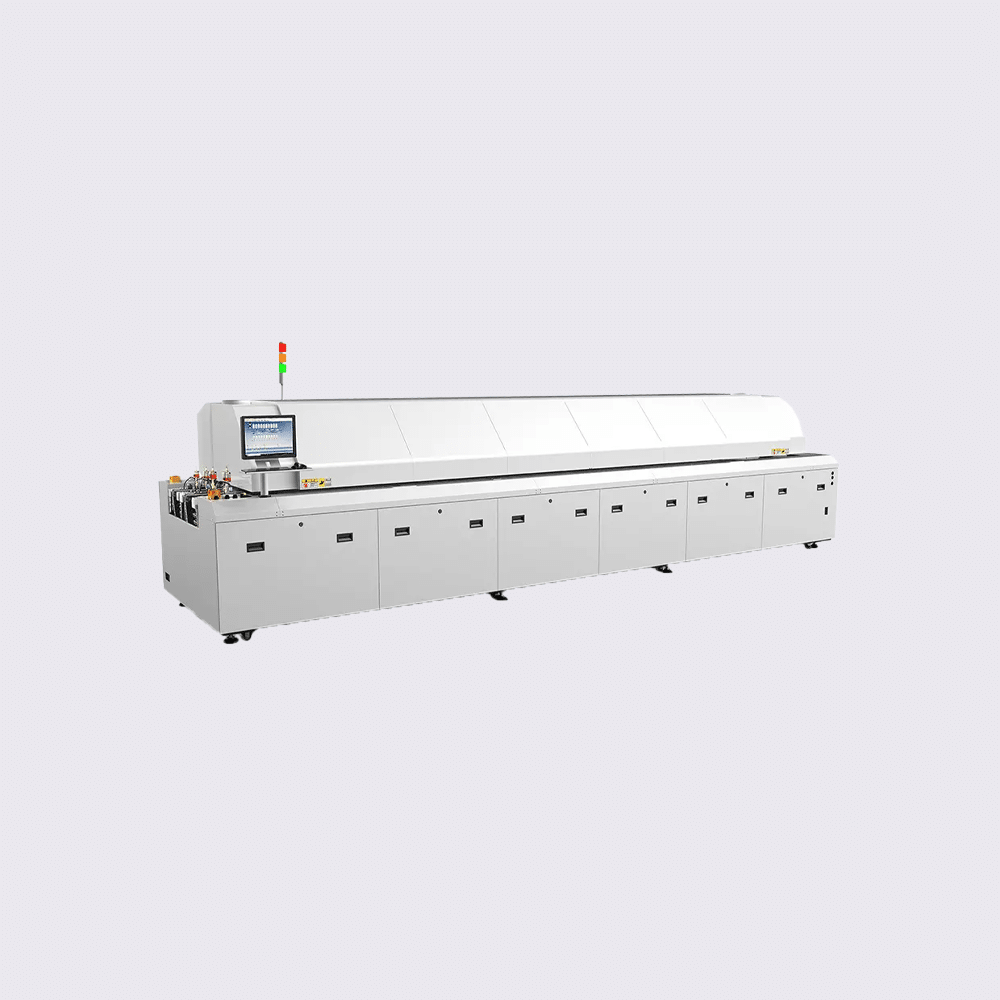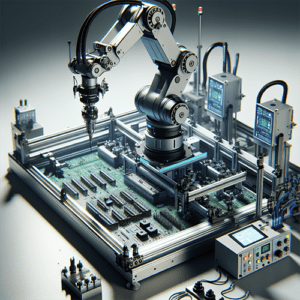Juki smt line for pcb board assembly
Have you ever wondered how those intricate circuit boards in your electronic devices are assembled with such precision? □ As someone who’s been in the PCB manufacturing industry for years, I can tell you it’s all about having the right equipment. And when it comes to top-notch assembly lines, Juki SMT lines are the unsung heroes of PCB board assembly.
I remember the first time I saw a Juki SMT line in action. It was like watching a perfectly choreographed dance of machines, each component finding its exact place on the board with mind-boggling speed and accuracy. That’s when I realized: this is the future of electronics manufacturing. Whether you’re a seasoned pro or just dipping your toes into the world of PCB assembly, understanding Juki SMT lines can be a game-changer for your production process.
In this post, I’ll take you on a journey through the fascinating world of Juki SMT lines for PCB board assembly. We’ll explore everything from the basic components that make up these marvels of engineering to the benefits they bring to your assembly line. I’ll share insider tips on selecting the right Juk needs and how to optimize its performance. Plus, we’ll look at real-world success stories that’ll inspire you to take your PCB assembly to the next level. Ready to revolutionize your production process? Let’s dive in! 💪🔧
Understanding Juki SMT Lines
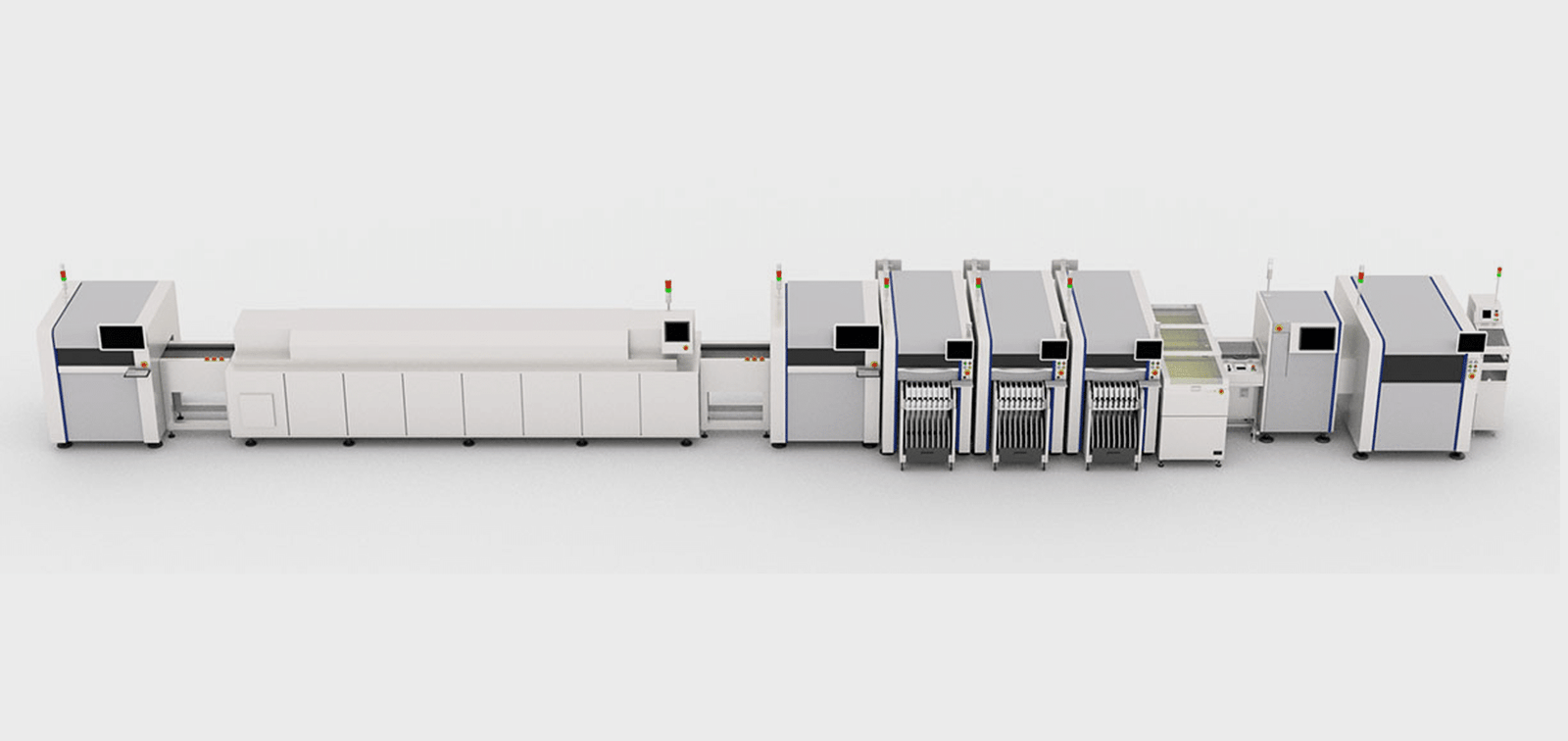
As I delve into the world of PCB assembly, I find myself continually impressed by the technological advancements that have revolutionized the industry. One such innovation that has caught my attention is
the Juki SMT line. In this section, I’ll share my insights on Surface Mount Technology (SMT), its crucial role in PCB assembly, and why Juki stands out as a leading manufacturer in this field.
What is SMT and its importance in PCB assembly
Surface Mount Technology, or SMT, is a method for producing electronic circuits where components are mounted directly onto the surface of printed circuit boards (PCBs). As I’ve explored this technology, I’ve come to appreciate its significance in modern electronics manufacturing.
The basics of SMT
SMT involves placing and soldering electronic components onto the surface of a PCB. This is in contrast to the older through-hole technology, where component leads are inserted through holes in the board.
Here’s a quick comparison:
Feature
SMT
Through-hole Technology
Component Size
Smaller
Larger
Board Space Utilization
More efficient
Less efficient
Assembly Speed
Faster
Slower
Automated Assembly
Highly suitable
Less suitable
Component Density
Higher
Lower
Why SMT is crucial for PCB assembly
Miniaturization: As I’ve witnessed the evolution of electronics, I’ve seen devices become smaller and more powerful. SMT allows for the use of smaller components, enabling the creation of compact yet feature-rich devices.
Increased Functionality: With SMT, I can fit more components onto a single board, leading to enhanced functionality within the same or smaller footprint.
Improved Performance: SMT components typically have shorter leads or no leads at all, reducing parasitic capacitance and inductance. This results in better high-frequency performance, which is crucial in today’s high-speed electronic devices.
Cost-effectiveness: While the initial investment in SMT equipment can be significant, I’ve found that the long-term benefits often outweigh the costs. SMT allows for higher production rates and reduced material costs.
Automation Friendly: SMT is highly compatible with automated assembly processes, which I’ve seen lead to increased productivity and consistency in manufacturing.
Enhanced Reliability: SMT components are generally more resistant to shock and vibration due to their direct surface mounting, improving the overall reliability of the final product.
Key features of Juki SMT lines
As I’ve explored various SMT solutions, Juki’s offerings have consistently impressed me with their advanced features and capabilities. Here are some key features that set apart:
High-Speed Placement: are known for their impressive placement speeds. I’ve seen some models capable of placing up to 100,000 components per hour, significantly boosting production efficiency.
Precision and Accuracy: With placement accuracy as fine as ±0.025mm, Juki machines ensure that even the smallest components are placed correctly, minimizing errors and rework.
Flexibility: Many Juki SMT lines I’ve encountered offer multi-functional placement heads, allowing for the handling of a wide range of component types and sizes.
Intelligent Feeders: Juki’s intelligent feeder systems have caught my attention with their ability to automatically detect and correct pick-up errors, enhancing overall line efficiency.
Advanced Vision Systems: The integrated vision systems in provide real-time component inspection and placement verification, which I find crucial for maintaining high-quality standards.
User-Friendly Interface: From my experience, intuitive user interfaces make machine operation and programming relatively straightforward, even for complex assembly tasks.
Modular Design: The modular nature of allows for easy customization and future upgrades, which I appreciate for its cost-effectiveness and adaptability to changing production needs.
Auto-Recovery Function: This feature has impressed me with its ability to automatically recover from errors without manual intervention, minimizing downtime.
Intelligent Component Management: software solutions for component management and traceability have proven invaluable in my projects, especially for high-mix, low-volume production.
Energy Efficiency: Many incorporate energy-saving features, which I find particularly important in today’s environmentally conscious manufacturing landscape.
Overview of Juki as a leading SMT equipment manufacturer
As I’ve delved deeper into the world of SMT equipment, consistently stood out as a leader in the field. Let me share some insights into why Juki has earned this reputation:
Historical Background
Juki Corporation, founded in 1938, initially focused on sewing machines. However, their expertise in precision machinery led them to diversify into industrial equipment, including SMT systems. I find their journey from sewing machines to high-tech electronics assembly fascinating and indicative of their adaptability and innovation.
Technological Innovation
In my experience, Juki has consistently been at the forefront of SMT technology. They were among the first to introduce:
Laser-based component alignment systems
Intelligent feeder systems
Advanced software for production optimization. Their commitment to R&D has resulted in numerous patents and industry-first technologies, which I’ve seen translate into more efficient and reliable SMT solutions.
Global Presence
global reach has impressed me. With manufacturing facilities in Japan and China and sales and support offices worldwide, they provide localised support and quick response times. This global presence has allowed them to understand and cater to diverse market needs.
Comprehensive Product Range
What I appreciate about is their comprehensive range of SMT equipment:
Pick and Place Machines: From high-speed to flexible placement solutions
Printers: For precise solder paste application
Reflow Ovens: For reliable soldering
Automated Optical Inspection (AOI) Systems: For quality control
Software Solutions: For production management and optimization
This wide range allows for the creation of complete, integrated SMT lines, which I find particularly valuable for ensuring compatibility and streamlined operations.
Customer-Centric Approach
In my interactions with Juki and from industry feedback, I’ve noticed their strong focus on customer needs. They offer:
Customized solutions for specific production requirements
Comprehensive training programs
Responsive after-sales support
This customer-centric approach has fostered long-term relationships with many electronics manufacturers, contributing to Juki’s leading position in the industry.
Quality and Reliability
Juki’s commitment to quality is evident in their ISO 9001 and ISO 14001 certifications. From my observations, their machines are known for their durability and long service life, which translates to a lower total cost of ownership for users.
Industry Recognition
Over the years, I’ve seen numerous industry awards for their SMT equipment. These accolades, along with positive user testimonials, reinforce their position as a leading manufacturer in the field.
Sustainability Initiatives
In recent years, I’ve been particularly impressed by focus on sustainability. They’ve introduced energy-efficient models and implemented environmentally friendly manufacturing processes. This aligns well with the growing emphasis on sustainable manufacturing practices in the electronics industry.
Partnerships and Collaborations
Juki’s collaborations with other industry leaders in areas such as software integration and Industry 4.0 initiatives have caught my attention. These partnerships demonstrate their commitment to providing comprehensive, future-ready solutions.
As I reflect on Juki’s position in the SMT equipment market, I’m convinced that their combination of technological innovation, global presence, comprehensive product range, and customer-centric approach has solidified their status as a leading manufacturer. Their solutions have consistently met the evolving needs of the electronics manufacturing industry, from high-volume production to flexible, high-mix scenarios.
In my experience working with various SMT solutions, I’ve found Juki’s equipment to be reliable, efficient, and user-friendly. Their continued investment in R&D and commitment to addressing industry challenges gives me confidence in their ability to remain at the forefront of SMT technology.
As we move forward, it’s crucial to understand how these advanced SMT lines, particularly those from Juki, are composed and what specific components contribute to their impressive capabilities. In the next section, we’ll explore the various components that make up a Juki SMT line, providing a deeper understanding of how these sophisticated systems operate to deliver high-quality PCB assembly.
Components
Now that we’ve covered the basics, let’s dive into the essential components that make up these advanced PCB assembly systems. As someone who has worked extensively, I can tell you that understanding these components is crucial for maximizing efficiency and quality in your PCB production process.
Automated Optical Inspection (AOI) Systems
One of the most critical components in my is the Automated Optical Inspection (AOI) system. This high-tech piece of equipment plays a vital role in ensuring the quality and accuracy of my PCB assemblies.
How AOI Systems Work
AOI systems use advanced cameras and sophisticated software algorithms to inspect PCBs at various stages of the assembly process. Here’s how I use them :
Pre-reflow inspection: I use AOI to check for proper component placement and solder paste deposition before the boards enter the reflow oven.
Post-reflow inspection: After reflow soldering, I run another AOI check to detect any defects that may have occurred during the soldering process.
Final inspection: Before shipping, I perform a final AOI scan to ensure the highest quality standards are met.
Benefits of AOI Systems
I’ve found that incorporating AOI systems into my offers several advantages: Increased accuracy: AOI can detect defects that might be missed by human inspectors.
- Higher throughput: These systems can inspect PCBs much faster than manual inspection methods.
- Consistent quality: AOI provides consistent results, eliminating variations in human judgment.
- Data collection: I use the data gathered by AOI systems to improve my manufacturing processes continually.
Types of Defects Detected by AOI Systems
My AOI systems are capable of identifying a wide range of defects, including:
Defect Type | Description |
Missing components | Components that should be present but are absent |
Misaligned components | Components that are not correctly positioned |
Solder bridges | Unwanted connections between solder pads |
Insufficient solder | Not enough solder on component leads or pads |
Tombstoning | Components standing on end due to uneven soldering |
Polarity issues | Components installed in the wrong orientation |
1. Pick and Place Machines
Pick and place machines are the workhorses of my Juki SMT line. These machines are responsible for accurately placing components onto the PCB at high speeds.
How Pick and Place Machines Work
The process of component placement in my Juki pick and place machines involves several steps:
Component feeding: Components are loaded into the machine via tape and reel, trays, or tubes.
PCB loading: The PCB is loaded onto the conveyor system.
Vision alignment: Cameras locate fiducial markers on the PCB for precise alignment.
Component pickup: A vacuum nozzle picks up the component from the feeder.
Component placement: The nozzle moves to the correct position and places the component on the PCB.
Placement verification: Some machines have built-in verification systems to ensure correct placement.
Key Features of Juki Pick and Place Machines
My Juki pick and place machines offer several advanced features that enhance their performance: High-speed placement: Some models can place up to 100,000 components per hour.
Multi-nozzle heads: This allows for simultaneous placement of multiple components.
Automatic nozzle changing: The machine can switch nozzles to accommodate different component sizes.
Advanced vision systems: These ensure accurate component placement and can detect errors in real-time.
Flexible programming: I can easily program new PCB designs and component layouts.
Types of Components Handled
My Juki pick and place machines can handle a wide variety of component types, including:
- Surface Mount Devices (SMDs)
- Ball Grid Arrays (BGAs)
- Quad Flat Packages (QFPs)
- Small Outline Integrated Circuits (SOICs)
- Chip resistors and capacitors
- LEDs
Importance of Accuracy and Speed
In my experience, the accuracy and speed of pick and place machines are crucial for the overall efficiency of the SMT line. Here’s why:
Accuracy: Precise placement is essential for proper electrical connections and to avoid solder bridges or open circuits.
Speed: Faster placement rates increase overall throughput and reduce production costs.
Consistency: Machines maintain consistent performance over long production runs, unlike human operators who may tire.
2. Solder Paste Printers
The solder paste printer is the first machine in my and plays a critical role in the assembly process. It’s responsible for applying solder paste to the PCB in precise amounts and locations.
How Solder Paste Printers Work
The solder paste printing process involves these steps:
Stencil alignment: A metal stencil with openings corresponding to the solder pad locations is aligned with the PCB.
Paste application: Solder paste is spread across the stencil surface.
Squeegee action: A squeegee moves across the stencil, forcing solder paste through the openings onto the PCB.
Stencil separation: The stencil is lifted away, leaving solder paste deposits on the PCB pads.
Key Features of Juki Solder Paste Printers
My Juki solder paste printers offer several advanced features:
Automatic stencil alignment: This ensures precise alignment between the stencil and PCB.
Programmable paste volume: I can adjust the amount of paste deposited for different component types.
Closed-loop pressure control: This maintains consistent paste deposition across the entire PCB.
Automatic cleaning systems: These keep the stencil clean for consistent print quality.
Inspection capabilities: Some models include built-in inspection systems to verify print quality.
Importance of Proper Solder Paste Application
In my experience, proper solder paste application is crucial for several reasons:
Joint quality: The right amount of solder paste ensures strong, reliable solder joints.
Component alignment: Excess solder paste can cause components to float and misalign during reflow.
Defect prevention: Insufficient solder paste can lead to open circuits or weak connections.
Process efficiency: Correct paste application reduces the need for rework and improves overall yield.
Solder Paste Types
I use different types of solder paste depending on the specific requirements of each project:
Solder Paste Type | Melting Point | Common Applications |
Leaded (Sn63Pb37) | 183°C | General-purpose electronics |
Lead-free (SAC305) | 217-220°C | RoHS-compliant products |
Low-temperature | 138-150°C | Temperature-sensitive components |
No-clean | Varies | Applications where cleaning is difficult |
Stencil Considerations
The stencil used in the solder paste printer is a critical component that affects print quality. Here are some factors I consider when selecting stencils:
Thickness: Thicker stencils deposit more solder paste, which is useful for larger components.
Material: Stainless steel is common, but nickel and polymer stencils are used for specific applications.
Aperture design: The shape and size of the stencil openings affect paste release and print quality.
Nano-coating: Some stencils have special coatings to improve paste release and reduce cleaning frequency.
By understanding and optimizing each of these components , I’m able to achieve high-quality PCB assemblies with maximum efficiency. The seamless integration of these components – from solder paste printing to automated inspection, allows me to produce complex PCBs quickly and accurately.
Next, we’ll explore the numerous benefits of using SMT lines for PCB assembly, including how these advanced systems can improve your production quality, speed, and overall efficiency.
3.Reflow Ovens
Reflow ovens are another crucial component of my Juki SMT line. These specialized ovens are designed to melt solder paste and create permanent connections between components and the PCB.
How Reflow Ovens Work
The reflow process in my Juki SMT line involves several stages:
Preheat: This stage gradually raises the temperature of the PCB and components to prevent thermal shock.
Soak: The temperature is held steady to allow for even heat distribution across the board.
Reflow: The temperature is raised above the melting point of the solder, causing it to liquefy and form connections.
Cooling: The temperature is gradually lowered to solidify the solder joints.
Types of Reflow Ovens
In my experience with Juki SMT lines, I’ve worked with several types of reflow ovens:
Convection reflow ovens: These use heated air to transfer heat to the PCB.
Infrared reflow ovens: These use infrared radiation to heat the PCB and components directly.
Vapor phase reflow ovens: These use a special liquid that vaporizes at a precise temperature to heat the PCB.
Key Features of Juki Reflow Ovens
Juki reflow ovens in my SMT line offer several advanced features:
Multiple heating zones: This allows for precise temperature control throughout the reflow process.
Nitrogen atmosphere option: Some models can create a nitrogen-rich environment to improve solder joint quality.
Profile creation and storage: I can create and save multiple reflow profiles for different PCB types.
Real-time temperature monitoring: This ensures that each board follows the correct temperature profile.
Benefits of Using Juki SMT Lines for PCB Assembly
Now that we’ve explored the components of a Juki SMT line, let’s dive into the numerous benefits these systems offer for PCB assembly. As someone who has worked extensively with Juki SMT lines, I can confidently say that they are game-changers in the world of electronics manufacturing. Let me walk you through the advantages that make Juki SMT lines stand out from the competition.
Flexibility for various PCB sizes and components
One of the most significant benefits I’ve experienced with Juki SMT lines is their incredible flexibility. These systems are designed to handle a wide range of PCB sizes and components, making them versatile enough to adapt to various production needs.
Accommodating different PCB sizes
Juki SMT lines can easily accommodate PCBs of different sizes, from small, compact boards used in mobile devices to larger ones found in industrial equipment. This flexibility is crucial in today’s diverse electronics market, where product sizes and specifications can vary greatly.
Small PCBs (e.g., for wearables): As small as 50mm x 50mm
Medium PCBs (e.g., for consumer electronics): Typically 100mm x 100mm to 200mm x 200mm
Large PCBs (e.g., for industrial applications): Up to 460mm x 510mm
Handling various component types
What I find particularly impressive about their ability to handle a wide array of component types. From tiny 01005 chip components to larger BGAs and QFPs, these machines can place them all with precision. Here’s a list of component types that Juki SMT lines can handle:
Chip components (resistors, capacitors)
ICs (integrated circuits)
BGAs (Ball Grid Arrays)
QFPs (Quad Flat Packages)
SOICs (Small Outline Integrated Circuits)
LEDs
Connectors
This versatility means that I can use a single for multiple projects, reducing the need for specialized equipment and saving valuable floor space in the production facility.
Improved product quality
In my experience, one of the most significant advantages of using for PCB assembly is
the substantial improvement in product quality. These advanced systems incorporate several features that contribute to producing high-quality PCBs consistently.
Precise component placement
Juki SMT lines are renowned for their ability to place components with extreme precision. The advanced vision systems and high-precision motors ensure that each component is placed exactly where it should be on the PCB. This level of accuracy is crucial for:
Preventing solder bridges
Ensuring proper electrical connections
Minimizing the risk of component misalignment
Advanced inspection capabilities
Many Juki SMT lines come equipped with built-in inspection systems that can detect issues in real-time. These systems use high-resolution cameras and sophisticated algorithms to identify:
Missing components
Misaligned components
Incorrect component polarity
Solder paste defects
By catching these issues early in the production process, I can prevent defective boards from moving further down the line, saving time and resources.
Consistent solder paste application
The solder paste printing process is critical for ensuring good electrical connections and mechanical strength in the final product often include advanced stencil printers that apply solder paste with remarkable consistency. This leads to:
Improved solder joint quality
Reduced risk of solder bridging
Better overall board reliability
Temperature control during reflow
Juki reflow ovens, which are often part of the SMT line, offer precise temperature control throughout the soldering process. This ensures that components are soldered correctly without being exposed to excessive heat, which could damage sensitive parts.
Reflow Stage | Temperature Range | Purpose |
Preheat | 150°C – 200°C | Activate flux, remove volatiles |
Soak | 150°C – 217°C | Equalize temperatures across the board |
Reflow | 217°C – 250°C | Melt solder, form joints |
Cooling | 250°C – Room Temp | Solidify solder joints |
This level of control results in stronger, more reliable solder joints and reduces the risk of thermal damage to components or the PCB itself.
Reduced labor costs
One of the most compelling benefits I’ve observed when using for PCB assembly is the significant reduction in labor costs. This advantage stems from several factors:
Automation of manual tasks
Juki SMT lines automate many tasks that would traditionally require manual labor. This automation includes:
Component placement
Solder paste application
Board handling and transfer between stations
Basic inspection tasks
By automating these processes, I’ve been able to reduce the number of operators required on the production floor. This not only cuts direct labor costs but also minimizes the risk of human error, which can lead to costly rework or scrapped boards.
Higher throughput with fewer operators
The speed and efficiency of Juki SMT lines mean that a single line can often replace multiple manual assembly stations. In my experience, a well-optimized Juki SMT line can achieve throughput rates of:
Up to 100,000 components per hour for high-speed chip shooters
20,000 to 40,000 components per hour for flexible modular placers
This high throughput means that fewer operators are needed to achieve the same or even higher production volumes compared to manual assembly methods.
Reduced training time and costs
Standardized operating procedures
While operating a does require skilled personnel, the training time and associated costs are often lower compared to training a team of manual assembly operators. The reasons for this include:
User-friendly interfaces on Juki equipment
Built-in error prevention featureIn my experience, an operator can typically be trained to run a Juki SMT line effectively within a few weeks, compared to the months it might take to train a skilled manual assembly technician.
Minimized rework and repair costs
The improved accuracy and consistency of lead to fewer defects in the assembled PCBs. This reduction in defects translates directly to lower rework and repair costs. I’ve seen cases where implementing a Juki SMT line has reduced rework rates from 5-10% down to less than 1%, resulting in significant cost savings.
Enhanced accuracy and precision
In my years of working with PCB assembly, I’ve come to appreciate the enhanced accuracy and precision that Juki SMT lines bring to the table. This level of precision is crucial in today’s electronics industry, where components are getting smaller and board designs more complex.
Micron-level placement accuracy
Juki SMT lines are capable of placing components with incredible accuracy. Most modern Juki pick-and-
place machines can achieve placement accuracies of:
±25 microns for chip components
±35 microns for fine-pitch ICs
To put this in perspective, a human hair is about 70 microns in diameter. This level of accuracy is essential for:
Placing ultra-fine pitch components
Ensuring proper alignment for BGA packages
Maintaining consistent spacing between components
Advanced vision systems
The accuracy of Juki SMT lines is largely due to their advanced vision systems. These systems use high-resolution cameras and sophisticated image processing algorithms to:
- Precisely locate fiducial marks on the PCB
- Detect and correct for board warpage
- Identify and adjust for component lead coplanarity issues
- In my experience, these vision systems can detect issues that would be nearly impossible for the human eye to spot consistently.
- Closed-loop feedback systems
Many Juki SMT lines incorporate closed-loop feedback systems that continuously monitor and adjust the placement process. These systems:
Measure the actual placement of components
Compare the placement to the programmed coordinates
Make real-time adjustments to maintain accuracy
This constant self-correction ensures that accuracy is maintained throughout long production runs, even as environmental conditions change or mechanical wear occurs.
Precision in solder paste deposition
The accuracy of Juki SMT lines extends beyond component placement to the solder paste printing process. Modern Juki stencil printers can achieve:
Print accuracy of ±20 microns
Consistent solder paste volume across the board
This precision in solder paste deposition is crucial for: Ensuring proper solder joint formation
Preventing solder bridges between fine-pitch leads
Maintaining consistent electrical and mechanical properties of the solder joints
Increased production efficiency
One of the most significant benefits I’ve experienced with Juki SMT lines is the dramatic increase in production efficiency. These systems are designed to maximize throughput while maintaining high quality standards, resulting in a more streamlined and productive PCB assembly process.
High-speed component placement
Juki SMT lines are capable of placing components at impressive speeds. In my experience, a typical high-end Juki pick-and-place machine can achieve:
Up to 100,000 components per hour for chip shooters 20,000 to 40,000 components per hour for flexible modular placers
This high-speed placement capability means that even complex boards with thousands of components can be assembled in a matter of minutes.
Minimal downtime
Juki SMT lines are designed for continuous operation with minimal downtime. Features that contribute to this include:
Quick-change nozzles and feeders
On-the-fly feeder replenishment
Automated board transfer between stations
Intelligent component inventory management
These features allow the line to keep running even during routine maintenance tasks, significantly increasing overall equipment effectiveness (OEE).
Efficient changeover between products
In today’s manufacturing environment, flexibility is key. Juki SMT lines excel in this area by offering quick and efficient changeover between different PCB designs. Some of the features that facilitate this include:
- Software-driven setup and programming
- Modular feeder banks for quick reconfiguration
- Automatic width adjustment for conveyors
In my experience, a well-optimized Juki SMT line can achieve changeover times of less than 10 minutes for similar products, and under 30 minutes for completely different designs.
Intelligent line balancing
Juki SMT lines often incorporate software that automatically optimizes the distribution of placement tasks across multiple machines in the line. This intelligent line balancing:
- Maximizes the utilisation of each machine
- Minimises bottlenecks in the production process
- Adapts to changes in component availability or machine status
The result is a smoother, more efficient production flow that maximises the output of the entire line. Integration with Industry 4.0 concepts.Many modern Juki SMT lines are designed with Industry 4.0 principles in mind. They can integrate with: Manufacturing Execution Systems (MES)
Enterprise Resource Planning (ERP) systems
Real-time production monitoring and analytics tools
This integration allows for:
Real-time production tracking
Predictive maintenance scheduling
Automated material replenishment
Data-driven process optimization
By leveraging these Industry 4.0 capabilities, I’ve seen manufacturers achieve significant improvements in overall production efficiency, with some reporting increases of 20-30% in their output after implementing fully integrated Juki SMT lines.
In conclusion, the benefits of using Juki SMT lines for PCB assembly are numerous and significant. From the flexibility to handle various PCB sizes and components to improved product quality, reduced labor costs, enhanced accuracy, and increased production efficiency, these systems offer a compelling value proposition for electronics manufacturers. As we move forward, we’ll explore how to select the right Juki SMT line for your specific needs, ensuring that you can fully capitalize on these benefits in your own production environment.
